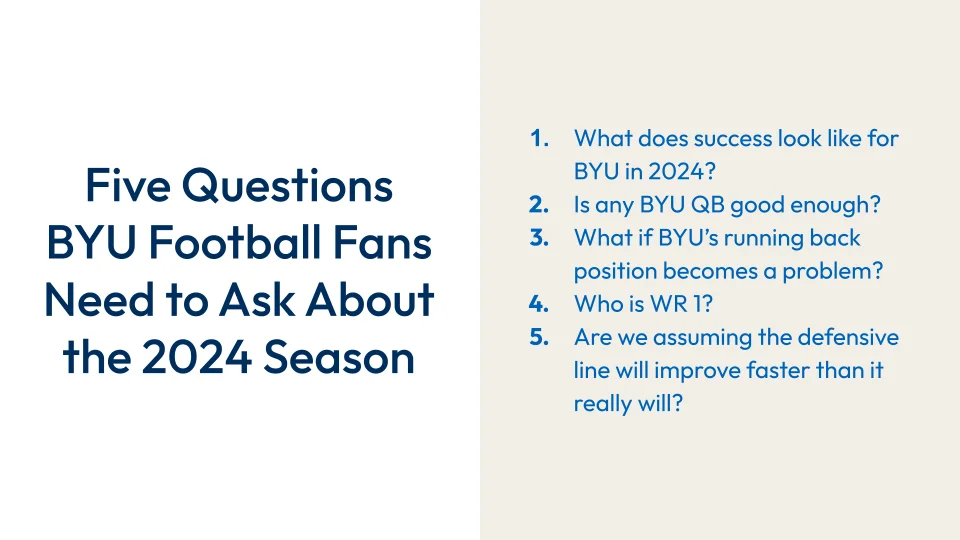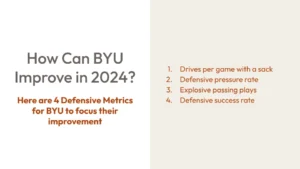In preparing for the 2024 college football season, I’ve found myself reflecting on the focuses of fans and media following the BYU football program. Much of the buzz is around the quarterback battle and the revamped defense. The offensive line’s traction has also been a topic of conversation. Then, there is the most commonly asked question of which surprise players whom we don’t really know or haven’t seen much are primed for a breakout season. But, then, I started to wonder, “Are these the right questions to be asking?” As I reflected further, I found five questions that BYU football fans need to ask about the 2024 season but are not currently doing so.
Here are the five questions that BYU football fans need to ask:
- What does success look like for BYU football in 2024?
- Regardless of who wins the starting quarterback job, is any quarterback on BYU’s roster good enough to help BYU improve?
- What if BYU’s running back position becomes a problem?
- Who is WR #1?
- Are we assuming that the defensive line will improve faster than it really will?
We’ll jump right into it.
RELATED CONTENT
Is BYU Basketball Putting Pressure on BYU Football to Improve Much Sooner?
How Can BYU Improve in 2024? Here are 4 Defensive Metrics
Question #1: What does success look like for BYU football in 2024?
I wrote about this extensively in a previous article and laid out my case for a focus on other indicators besides wins and losses in 2024. The first question BYU football fans need to ask is “What does success look like?” I’m worried less about BYU getting to 6+ wins and more focused on BYU being more competitive in every game. In short, I’m defining BYU’s 2024 season as a successful season if BYU decreases their negative point differential, or in other words, does not get blown out so much.
I’ll give you some metrics to understand where BYU was at in terms of a point differential. They will help set the benchmark of where BYU was.
A few metrics that illustrate how bad BYU struggled at times in 2023:
- BYU’s total point differential in 2023 was -81 points (point differential = points scored minus points allowed)
- In conference games, BYU’s point differential was -127
- From the TCU game through to the Iowa State game, BYU went 1-4 and was outscored by 111 points!
When you compare BYU’s point differential to the rest of the conference, you start to see how good they were, or weren’t…Take a look at the bottom half of the new Big 12 for the season and for conference play:
| School (sorted on conference play diff.) | Season Point Differential | Conference Play Point Differential |
| Arizona State | -169 | -131 |
| Baylor | -123 | -128 |
| BYU | -81 | -127 |
| Cincinnati | -71 | -123 |
| Colorado | -80 | -113 |
| Houston | -94 | -72 |
| Texas Tech | -2 | -30 |
| TCU | +42 | -13 |
BYU was bolstered up by their non-conference schedule. That won’t be quite the case in 2024 because their non-conference schedule will be more difficult.
No team in the new Big 12 (includes 2024 additions and subtractions) was as bad as BYU from week 7 through week 11. Consider the bottom half during that stretch:
| School | Win-Loss Record | Point Differential | # of Losses >= 28 Points |
| BYU | 1-4 | -111 | 4 |
| Houston | 2-3 | -55 | 1 |
| Cincinnati | 1-4 | -47 | 1 |
| Baylor | 1-3 | -44 | 1 |
| Arizona State | 2-3 | -39 | 1 |
| Colorado | 0-4 | -25 | 0 |
| Texas Tech | 2-2 | -20 | 0 |
| TCU | 1-3 | -15 | 1 |
All BYU fans know about that difficult stretch. For those who kept watching all the snaps (raising my hand), it was painfully obvious that BYU was going through growing pains in the Big 12. BYU was part of the 12 (er, 14), but sure didn’t look part of the Big.
Note the following from that table:
- BYU’s point differential was twice as bad as any other team
- BYU had 4 times the amount of bad losses (4 touchdowns or more) as any other team
While Houston and Cincinnati were also going through their pains, and Baylor was flirting with the idea of resuming its conference cellar dweller role, BYU was repeatedly getting pummeled, and pummeled, and pummeled again. I didn’t realize how bad BYU was struggling at that time.
Now, it did happen to be against some of the better competition in the conference that year. But, to be the best, you’ll have to beat the best at some point, as they say.
What I didn’t know is that BYU was close to the bottom of the Big 12 in terms of blowouts. Sure, they beat Cincinnati and had a better record than them and Houston, so I thought that BYU was doing better. But, when you look at blowout losses, you start scratching your head.
Let’s take a look in total at the number of losses of 28 points (4 TDs) or more by each team in 2023:
| School | Regular Season Record | # of Losses >= 28 Points |
| Arizona State | 3-9 | 4 |
| BYU | 5-7 | 4 |
| Baylor | 3-9 | 2 |
| Cincinnati | 3-9 | 2 |
| Colorado | 4-8 | 2 |
| Houston | 4-8 | 2 |
| TCU | 5-7 | 1 |
| Texas Tech | 6-6 | 1 |
| UCF | 6-6 | 1 |
| Iowa State | 7-5 | 1 |
| West Virginia | 8-4 | 1 |
| Utah | 8-4 | 1 |
| Oklahoma State | 9-3 | 1 |
| Kansas | 8-4 | 0 |
| Kansas State | 8-4 | 0 |
| Arizona | 9-3 | 0 |
While Baylor, Colorado, Cincinnati, and Houston all finished with worse records, they were not blown out as many times as BYU was. BYU was competitive in their first Big 12 loss and in their last 2 Big 12 losses. And, those losses were against some of the top conference competition.
I’m seeing a conundrum starting to form. Was BYU actually much closer to bowl eligibility than I thought, save for a 5 week stretch when they temporarily forgot who they were? After all, they were competitive against Kansas and nearly beat the Oklahomas.
Or, were they actually teetering on the edge of a 3-9 or 4-8 season?
BYU beat Cincinnati straight up, but what if the game were in Ohio? And, BYU caught Texas Tech on a fortunate week when the Red Raiders were down to a third string quarterback. Those games could have easily been flipped to a loss for the Cougs.
So, I’m setting my measuring sticks for success for BYU football in 2024 as the following:
- Decrease the season negative point differential from -81 by more than half, down in the -30 to -40 range
- Cut the conference play negative point differential in half, from -127 down to -65
If BYU accomplished these point differential improvements and didn’t make a bowl game, then I would still call this season a success. BYU plays one of the toughest, if not the toughest, conference schedules. Finding a way to bowl eligibility would be a miracle.
The first question BYU football fans need to ask is “What does success look like?” I’m worried less about BYU getting to 6+ wins and more focused on BYU being more competitive in every game. In short, I’m defining BYU’s 2024 season as a successful season if BYU decreases their negative point differential, or in other words, does not get blown out so much.
Question #2: Is any quarterback on BYU’s roster good enough to help BYU improve?
The popular question running on social media, Cougarboard, and in the news has been, “Who will win the starting quarterback job? Will it be Jake Retzlaff or Gerry Bohanon? What about McCae Hillstead?” But, is that the right question? No, the second question BYU football fans need to ask is, “Are any of our quarterbacks good enough to help BYU?”
I’m a fan of Jake Retzlaff, and Gerry Bohanon really impressed me in 2021. McCae Hillstead transferred in during the spring transfer portal, and while he has the upside, his 2023 was rough. I don’t have strong feelings about which one should be starting. Whoever ends up starting, and assuming it is one of those three, I want to see the quarterback at BYU succeed. But, setting aside fandom, do I believe that any of them are good enough to propel BYU forward?
The fact that there is not a clear starter has me concerned.
There are reasons to think that each quarterback has the upper hand. For Retlaff:
- He is the quasi incumbent, having started the last four games of 2023
- He has more time in the offensive system
- He has two years of eligibility as opposed to one
For Bohanon, he may have the upperhand for these reasons:
- He has much more experience under his belt
- He started for a team that won the Big 12 in 2021
For Hillstead, he may have the upperhand for these reasons:
- He has more eligibility, so the coaches may decide to turn to him and let him grow into the position this year, setting up for several more years of him at the helm
- His completion percentage was much better than Retzlaff’s in 2023
But, if nobody is the clear cut favorite right now, then is one of the following concerns true about each quarterback? For Retlaff:
- Did he not convince the coaches during those four games of 2023 that he can clearly lead the team?
- Has he not improved enough since 2023 to make himself the clear cut starter?
- His completion percentage was not quite 50% (that’s not great at all)
For Bohanon, the concerns are:
- Did he regress during his time at South Florida so much that he is struggling to beat out a mediocre quarterback in Retzlaff? (Statistically, yes)
- Is his shoulder injury lingering or did it restrict / stunt his progression?
For Hillstead, the concerns are:
- The TD to INT ratio (11:8) was not great. It’s almost a 1 to 1 ratio.
- Was he sacked 18 times in 2023 because of a poor offensive line? Or, because he was delayed in his decision making?
Remember, while Kedon Slovis was not officially knighted as Sir QB 1 until fall camp, he was running with the 1s and was QB1 from the beginning. No question in the program. Neither Kalani or Roderick made a big official announcement during the spring because they didn’t need to. It was evident to them who would be the starter.
If BYU accomplished these point differential improvements and didn’t make a bowl game, then I would still call this season a success. BYU plays one of the toughest, if not the toughest, conference schedules. Finding a way to bowl eligibility would be a miracle.
It is fair to say that Bohanon in 2021 was much better than Retzlaff was in 2023. Therefore, the fact that no quarterback has been chosen at this point tells me one of three things:
- Either Arod is pushing both of them to get better even though he knows who QB1 is, and Hillstead is part of future plans, or
- Retzlaff has really improved, and Bohanon has not regressed dramatically, and they are both are going to make BYU really competitive, and Hillstead is part of future plans and depth, or
- Retzlaff has not improved by leaps and bounds, and Bohanon has regressed dramatically from 2023, and BYU is really in a spot of trouble at the QB position now and in the future so they brought in another option in Hillstead.
I hope the reality is #1 or #2, but I’m leaning towards #3 here.
The reason I’m leaning towards #3 here is because Retzlaff and Bohanon both gave mediocre performances from 2022 – 2023.
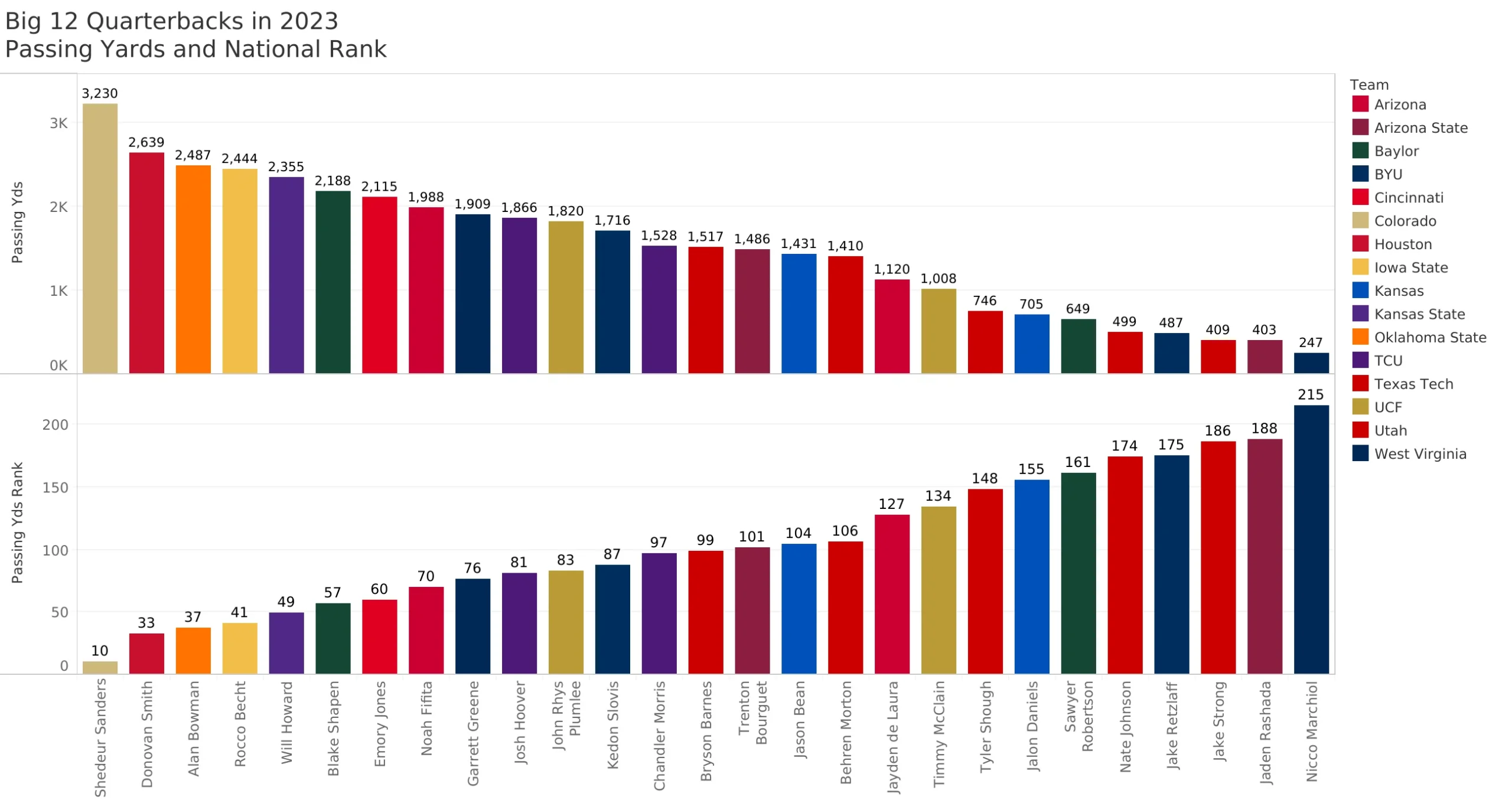
Data come from @cfbfastR
This graph shows the passing yards and national rank (from 2023) amongst the quarterbacks in the new Big 12. Because Retzlaff only played in 4 games, he clearly won’t have as many yards. Shedeur Sanders will be a figure to watch, as will Rocco Becht, Alan Bowman, and Noah Fifita.
Well, there might be a fair question then of how good does any of the QBs need to be? One way to begin to answer that question is to look at a few metrics and compare across Big 12 quarterbacks from 2023.
Take completion percentage, for example, and let’s see what we have. Though, you may want to unsee this after you look at it. Jake Retzlaff was among the worst in the country in completion percentage. And, going back to 2021, he was one of the worst that the Big 12 has seen…
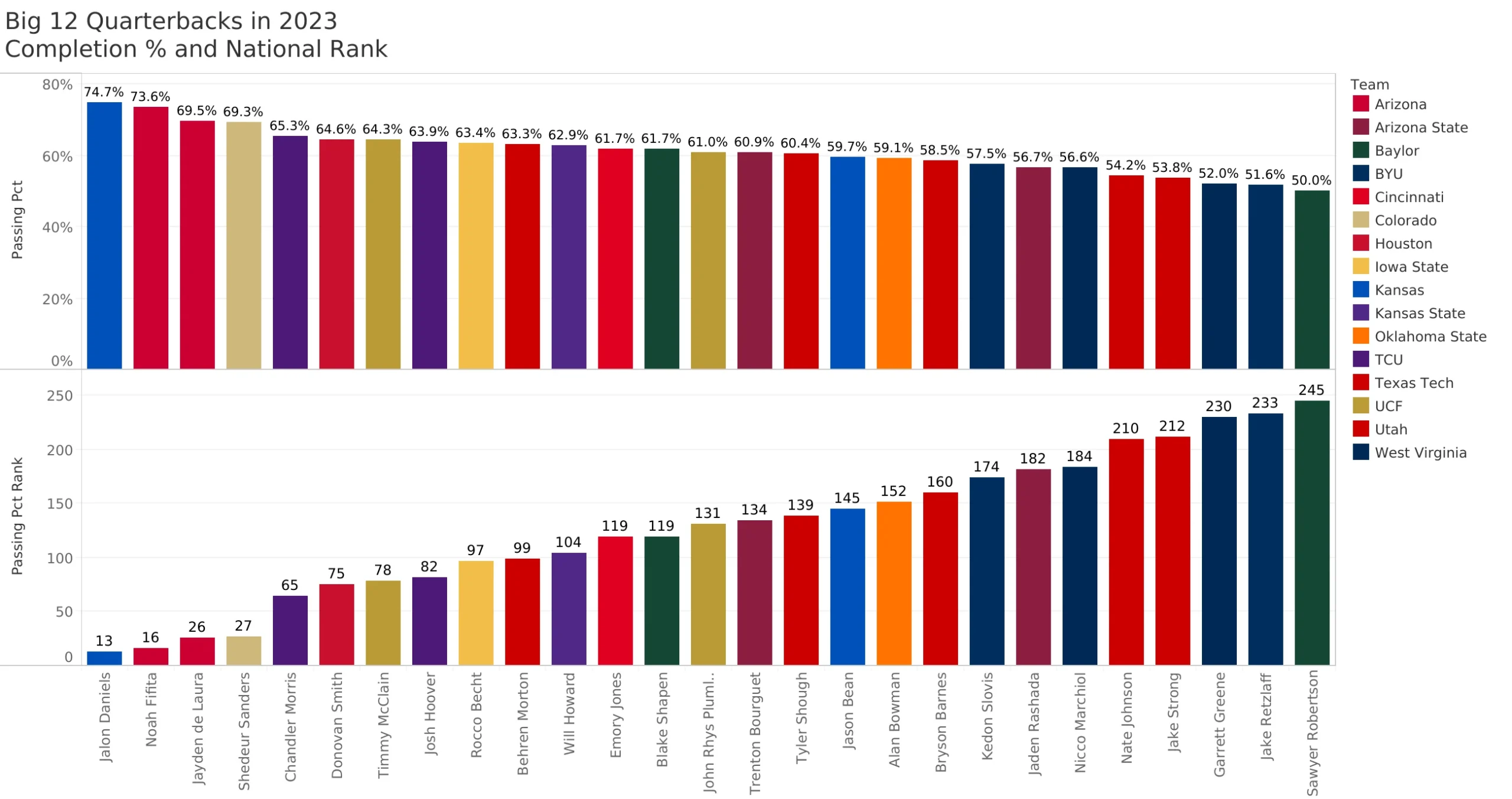
Data come from @cfbfastR
Jake Retzlaff finished with the 233rd best completion percentage in the country amongst quarterbacks who threw over 50 passes.
What stands out is that Jake completed about half of his passes. I really do root for him and want to see him succeed should he win the job. But, he really needs to improve! He was far too casual with the ball, which led to a poor completion percentage in addition to turnovers.
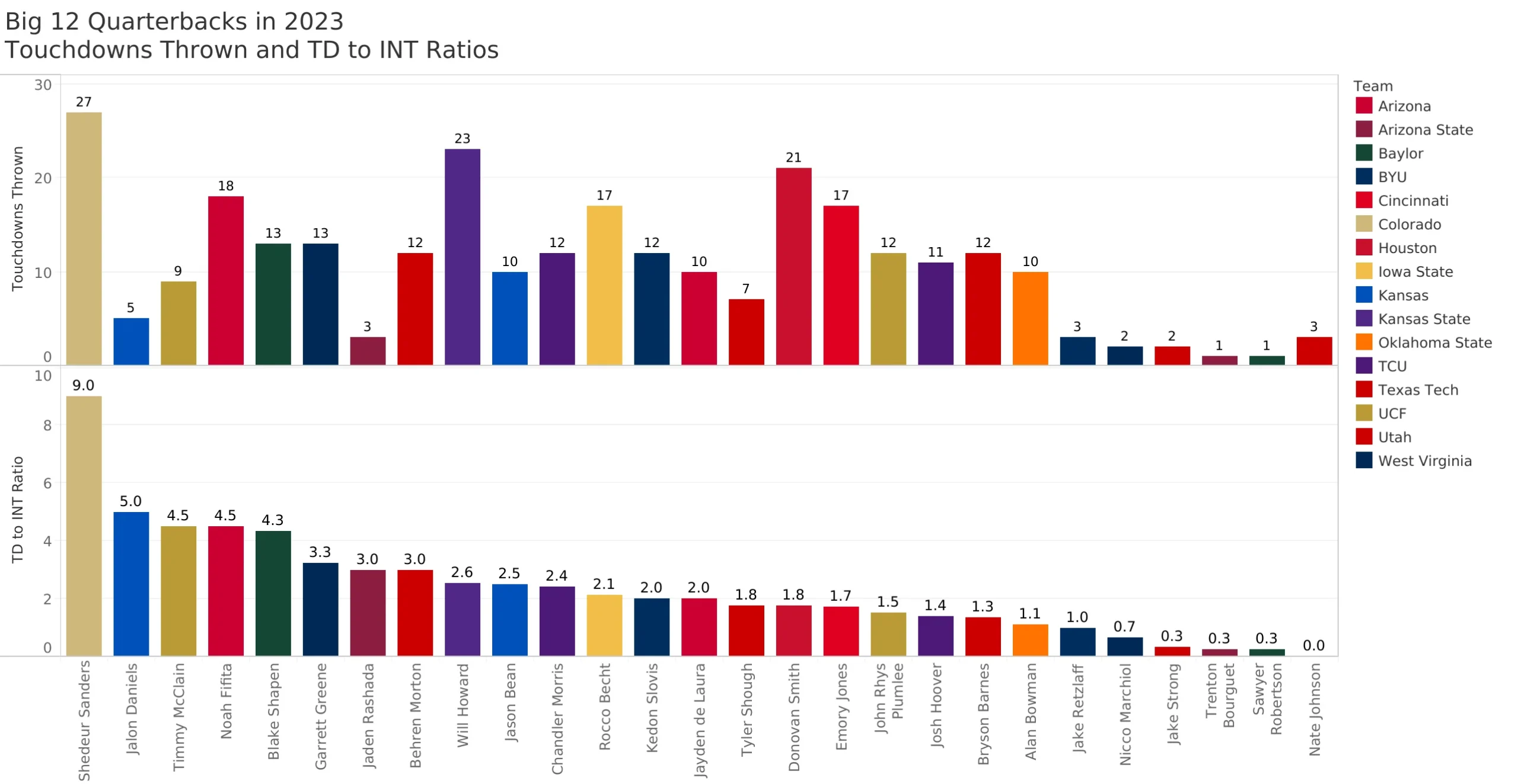
Data come from @cfbfastR
Retzlaff had a 1:1 TD to Int ratio. 3 TDs and 3 INTs. Not great. Though it wasn’t the worst, it clearly needs improvement. Shedeur Sanders shows here why he is going to be drafted in Round 1 in 2025. And Jalon Daniels, who didn’t play much, also shows that he is highly efficient.
When you start to look back at the past three years, then you begin to see that Gerry Bohanon was average to good during that 2021 season. And, you see that Jake was not great in 2023. So, this is why I am concerned. You also see that McCae Hillstead was not great.
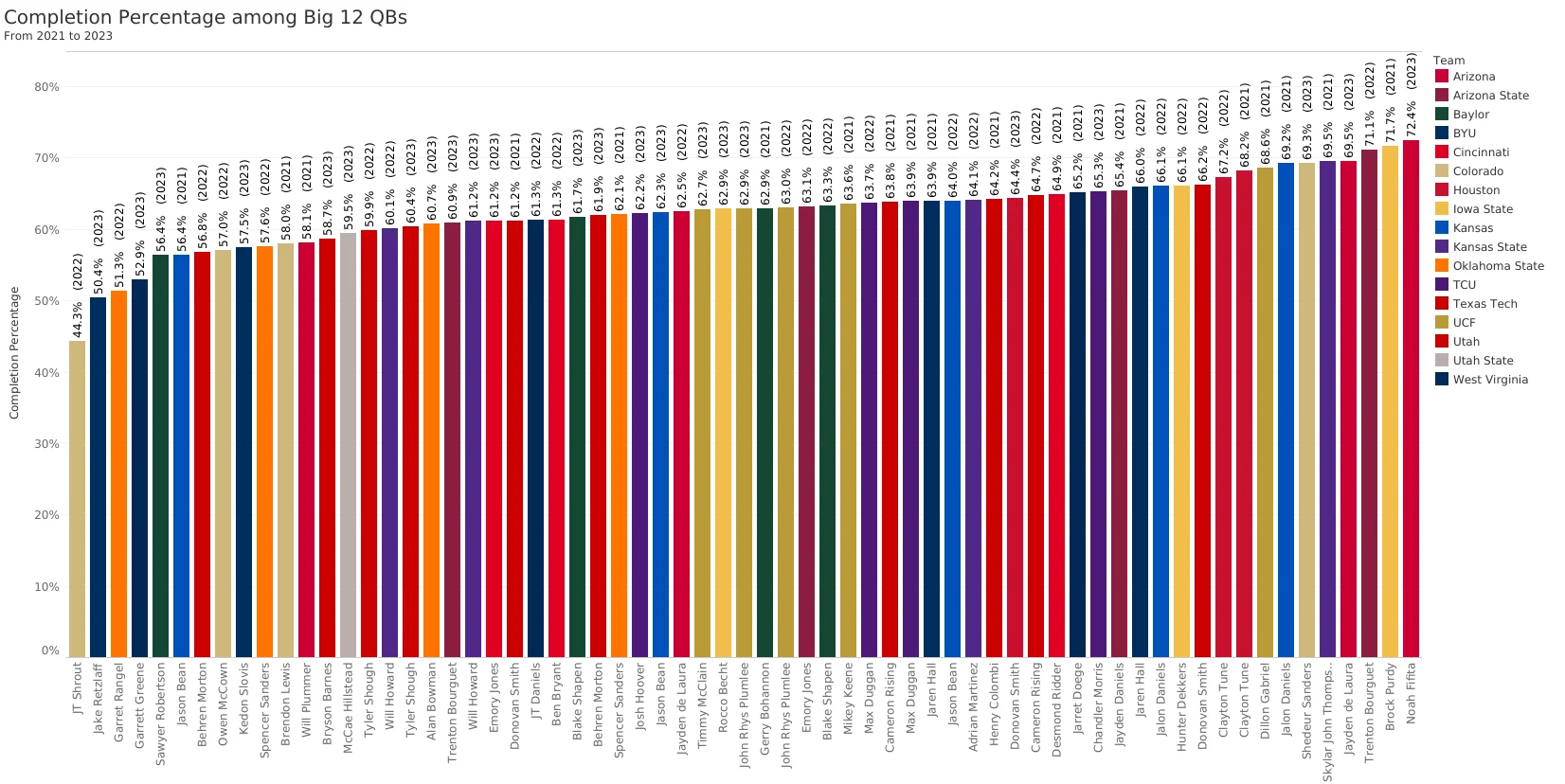
Data come from @cfbfastR
Jake Retzlaff is on the second to the last from the left. That is the wrong end of the graph to be at. He had the second worst completion percentage amongst quarterbacks with over 100 attempts on teams in the new Big 12 schools between the years 2021 to 2023.

Data come from @cfbfastR
When you look at passing yards per attempt, the story is even more bleak. Jake Retzlaff is in even more trouble. Among all quarterbacks with over 100 attempts from 2021 to 2023 across the schools that comprise the new Big 12, he was dead last. He only completed 5.2 yards per attempt. This is largely driven by the poor completion percentage.
Question #3: What if BYU’s running back position becomes a problem?
The third question BYU football fans will want to ask themselves honestly is whether or not we are as strong at running back as we think we are.
Let’s play out a few scenarios here. If BYU’s offensive line struggles again in 2024 and doesn’t get it right, then any running back deficiencies will be partly masked. But what if BYU’s offensive line, led by new coach TJ Woods, nails it?
How confident should BYU football fans feel about the running back position?
Aidan Robbins and Deion Smith exit the program, having accounted for 50% of the yardage production (647 yards) and 3 of the 8 TDs that came from the running back position. LJ Martin accounted for almost all the remaining production.
BYU fans are excited about LJ Martin. I am too! He had a knack for extending plays by 1-3 extra yards. That takes fight and determination, and is somewhat a skill to know how to fall and extend while protecting the ball. It takes an understanding of leverage points and balance.
But, consider this: He had 518 yards rushing, 100 of which came from two plays (45 yarder against Arkansas and 55 yarder against Texas Tech). He has a 4.8 yards per carry average with those two big plays. Take those two plays out, and his average drops to 3.9. Now, again, the offensive line shoulders much of the blame.
He didn’t make it through the entire season healthy last year. And, despite his potential, he still had freshmen moments where he missed the hole. This was mostly masked because of the offensive line struggles.
I have three questions running in my mind that all ultimately point to the broader question addressed by this section: “What if BYU’s running back position becomes a problem?”
The questions running in my mind are the following:
- Can LJ Martin be a lead back for a full Big 12 season?
- Can Miles Davis make the transition from situational role player to an every down contributor?
- Is Hinckley Ropati healthy and do we think he is also ready to make the transition from situational role player to an every down contributor?
This is the first year since 2020 that BYU enters a season without a bonafide star running back. In that 2020 year, BYU did return Lopini Katoa, but he only ran for 358 yards the season before. In 2021, BYU had Tyler Algeier returning. In 2022, they had Cal transfer Christopher Brooks. Last year, Aidan Robbins and to a lesser extent Deion Smith.
We think that LJ Martin is a stud and he showed enough glimpses to think that he can make the next step. There’s no question that he has potential to be an all-conference back before he leaves BYU. But, he still has the opportunity to grow and improve.
Miles Davis and Hinckley Ropati are known names, but in reality, they aren’t terribly known commodities because of the infrequency in which we’ve seen them play.
Miles Davis flashed a few big plays against Wyoming in 2022, which gave reason for excitement. But, he hasn’t done much since then despite my desire to see him get a bigger role. The word out of camp is that Aaron Roderick is really confident in him this season. Arod said, “He’s reached the point now where he can run the whole offense.” That might explain why he didn’t see a bigger role.
He reminds me of a 3rd year NBA player who was drafted high because of the size and athletic measurables on paper but has struggled to get consistent playing time. We see these players all the time. They’ll have a game where they pop for 30 points, and then they’ll be invisible for a 6 week stretch of games. Fans crave to see the player get more time, but there is usually something that the coaches see that we don’t that is the reason they are not getting more time.
It is tempting to think that after a 70 yard run against Wyoming in 2022 that Davis can be a star. But, he has to prove it now, and he will likely get the chance.
Hinckley Ropati is another curious case. He didn’t see the field in 2022 until the Notre Dame game when he promptly fumbled the ball on his first carry and was relegated back to the bench for a while. We didn’t see him again until the Boise State game, by which point BYU had dropped 4 straight games, and he saw 3 carries in addition to 3 pass receptions. One of those pass receptions was on a screen that went for a touchdown.
Against Utah Tech, Hinckley had 16 carries for 43 yards…which isn’t great. Then, against Stanford, he had 9 carries for 85 yards and 1 TD. Stanford was arguably one of the worst teams on BYU’s schedule that year. So, he didn’t play when BYU was battling their toughest opponents, and he did reasonably well against some of the weaker teams.
Now, am I trying to make something up when there isn’t any problem to be had? No, I’m genuinely not. But, successful fans set expectations that are reasonable so that reality ends up close to those expectations. The dismal, miserable, and pain-filled fans are those who set expectations at the “There’s no way we can lose this game” level and then are shocked when reality is different.
We’ve all been there. I’ve been there. Plenty. If I had to guess what direction the running back position will trend in 2024, I would say up. College football is such that underclassmen routinely have to wait for several years before they see the field, and then we see guys who haven’t had much time before suddenly perform really well.
I believe the same can happen this year. But, there is a scenario where BYU runs into problems at the running back position. And it is not a 5% or a 10% chance scenario. It’s not a 90% chance scenario. But, it is possible.
Question #4: Who is WR 1?
The general sentiment that I see among fans and commentators is that BYU has a strong wide receiving group. I don’t disagree. I feel confident about their group. I would argue they have more depth than they have had historically. But, this leads me to my fourth question BYU football fans should ask themselves. Who truly is WR 1 for the entire season?
Let me define what I mean by WR 1?
Think of Puka Nacua on 4th and goal from the 7 against Boise State in 2022. When healthy, we knew that we could count on Puka to produce. When BYU needed a first down, they knew they could go to Puka. When BYU needed to throw the “Jump ball” type of play, throw it to Puka.
If a team does not have a receiver who can get open and make a play at a critical juncture, then that team’s ceiling will be limited. It is equivalent to having a guy in basketball who can create his own shot when the pressure is on. Does BYU have that guy this year who can do that game in and game out?
I don’t know.
I want to believe that Chase Roberts could be that guy. He has the size you need (6’-4”) and the hands that you want. Can he consistently get open against the tougher, more talented DBs in the Big 12? He struggled in 2023.
“But, he had that amazing touchdown grab against Arkansas that was on SportsCenter’s Top 10!!” you proclaim. Yes, he did, and it was glorious. But, that was one game. Consider this: he was the leading receiver in 3 games all of 2023, and only one time did he get over 100 yards receiving.
100 yards receiving does not automatically constitute a WR 1, but backup wide receivers do not frequently get 100+ yards in a game. To get a 100+ yards, you’re either a burner, you can outjump guys, you are a precision route runner, or you’re on a team with 2-3 other guys who get double teamed and you’re still pretty good. These are generally characteristics of guys who can be a WR 1.
I recognize that there were issues offensively that were out of Chase’s and the other receivers’ control. But, as I reflect on the receiving group, it looks more like we have a group of really good WR 2 or WR 3 types. I’ll give that some of the guys can be WR 1 on a game or two. But can they do it for the season?
BYU had 5 different receivers lead the team in receiving yards for a game. Only one time did they go over 100 yards. In 2021, Nacua went over 100 yards three different times, and Gunnar Romney went for over 100 yards two times.
In 2022, Nacua struggled with injuries and played in 9 of the 13 games. Yet, he still had three games with over 100 yards. Keanu Hill, the newly converted tight end, had two games over 100 yards. Then, interestingly enough, both Chase Roberts and Kody Epps each had one game of 100+ yards.
When you look at Chase’s game by game receiving stats, you see that he came out of the gate hot and then really slowed down during Big 12 play, with the exception of the Cincinnati game:
| Week | Opponent | Receptions | Yards | Touchdowns | % of Total Yards | Cumulative % of Total Yards |
| 1 | Sam Houston State | 5 | 42 | 0 | 7% | 7% |
| 2 | Southern Utah | 6 | 84 | 1 | 15% | 22% |
| 3 | Arkansas | 2 | 12 | 1 | 2% | 24% |
| 4 | Kansas | 5 | 89 | 0 | 16% | 40% |
| 5 | Cincinnati | 6 | 131 | 1 | 23% | 62% |
| 7 | TCU | 3 | 63 | 0 | 11% | 73% |
| 8 | Texas Tech | 2 | 9 | 1 | 2% | 75% |
| 9 | Texas | 4 | 29 | 0 | 5% | 80% |
| 10 | West Virginia | 4 | 53 | 0 | 9% | 89% |
| 11 | Iowa State | 2 | 12 | 0 | 2% | 91% |
| 12 | Oklahoma | 2 | 45 | 1 | 8% | 99% |
| 13 | Oklahoma State | 1 | 4 | 0 | 1% | 100% |
What stands out to me here is that after 6 games in, Chase already generated 75% of his season production. If a receiver were to spread his receptions out evenly across the season like peanut butter, then you’d see roughly an 8% mark in the % of Total Yards column. Chase’s is all over the place.
It’s not surprising entirely though. Different opponents and different styles dictate different game plans. But the games against Texas Tech, Iowa State, and Oklahoma State were particularly difficult. Texas wasn’t much easier either.
As they got deeper into Big 12 play, the less he generally produced, more frequently going under that 8% clip. I would have liked to see him produce much more over the last three games of the season.
While I have confidence that the BYU receiver room is deep, I am uncertain if there is going to be a guy, be it Chase Roberts, Darius Lassiter, or possibly young guy JoJo Phillips, who can step up and be a true #1 for the entire season. I hope we do.
Question #5: Are we assuming that the defensive line will improve faster than it really will?
There was quite a bit of fanfare that went along with the defensive recruiting this most recent cycle. And, for good reason. Consider how the defensive line position recruiting has picked up year over year since 2020:
| Recruiting Cycle | # of Recruits | Avg Rating of Defensive Line Recruits (per 247) |
| 2020 | 3 | 81 |
| 2021 | 4 | 85 |
| 2022 | 0 | No defensive line recruits |
| 2023 | 9 | 85 |
| 2024 | 6 | 87 |
But, the last question BYU football fans need to honestly ask themselves is whether or not the defensive line will improve as fast as we hope.
When you listen to Jay Hill and Kalani Sitake after spring practices or on National Signing Day, you can hear the excitement from the coaches, particularly as they express traits about each player that don’t necessarily show up in the recruiting ratings. A message that I heard was that there is a belief that these recruits can develop into talent that recruiting ratings don’t quite capture.
It would be convenient if we had a two-part recruiting rating system (both parts are subjective, though one is MUCH more subjective). The first part is what we currently have – how good is the recruit right now relative to his peers. The second part would be new – what is the projected ceiling of each recruit in college relative to their peers.
I suspect that the staff in Provo believe that the 2024 recruits would score closer to the four star rating in this “ceiling” recruiting rating that I am suggesting.
However, here is where I am concerned as it relates to the 2024 season. Jay Hill spoke after several media sessions that some of these high school recruits are already showing signs of being in the two deep, if not actual Week 1 starters. While that validates the higher level recruiting rating and bodes well for the individual, it leaves me to question, “Do we really want several freshmen to come in and start on the defensive line?”
If these freshmen were 5-star, highly recruited and touted players coming in, then you would be glad to hear that they’re already pushing for playing time. But, these freshmen, as good as they are, were not the highly touted types. So, if they are competing for playing time, then you wonder how good the existing depth really was.
And, while I say “not highly touted”, I am not saying, “not highly talented”.
Remember, last year’s defensive line was one of the weaker lines in the Big 12, and by some metrics, one of the worst in the country. I wrote about this extensively when I took a look at their defense in 2023.
It is entirely possible that several freshmen come in, take over starting jobs, create excitement for the future, and yet they struggle in 2024.
On the contrary, it is also possible that they come in and the defensive line improves dramatically.
But, I believe that 2024 is going to be an uphill battle for the defensive line. The freshmen, and whoever sees the field, is going to continue to need time to develop, to build more strength and size. While I have questions about 2024, I do believe that this crop of recruits will improve and the line will see gains in 2025.
Remember, this team had 11 sacks in 2023. So, on one hand, there is almost nowhere to go but up. On the other hand, any improvement over what we had in 2023 doesn’t automatically mean bowl game and conference championship.
The defensive line could double the amount of sacks generated and they’d still be in the bottom half of college football.
Final Thought: Why ask these questions?
These questions are not intended to strike fear in the loyal fan’s heart. And, the answer to all of these questions could be that BYU has a great quarterback, deep running back room, bonafide #1 WR, and an excellent defensive line. So, before you get worried and negative, remember that these are simply questions.
And yet, these questions are helpful because they can help to properly set expectations. The most important step that a fan can take to have an enjoyable experience is to set proper expectations of what they want out of the experience.
If you expect BYU to go to a bowl game this year, then there is a good chance you will be disappointed. If you think BYU has a legitimate shot to go to the Big 12 title game, then you could be sorely disappointed come early December.
When setting our fan expectations, we don’t want to go too high, but we also don’t need to go too low. And yet, at the end of the day, we must remember that we’re setting our expectations on something that is largely out of our control.
Yes, we indirectly contribute to the quality of rosters and coaches by the money we spend and the eyeballs we direct towards broadcasts. But, when it comes to gameday, beyond our loud cheering, we can’t get on the field and make the tackles, catch the passes, or score a single point.
So, better to let go of what we can’t control and focus on what we can control. That is to expect to have fun, recognize there will be down moments, and to be pleasantly surprised when good things happen!
Cougar Nation – I salute you! You are proud and passionate! And, see if you can get the creamery to distribute ice cream to the entire stadiums. And, while you’re at it, have them mail out ice cream to any fan watching the game remotely that day! I’ll take one Graham Canyon please.
About 3rd Down Analysis (3DA): With a goal of fueling fan’s college football passion, 3rd Down Analysis brings an important combination of understanding the game of football while also knowing how to interpret what the data are telling us. Through long-form content, 3DA achieves this goal by dissecting data that is not easily accessible to fans and then sharing the bigger themes that are playing out on the field. Additionally, the business and financial background of the creator enables 3DA to share a unique viewpoint on the broader themes playing out across the college football landscape.
3rd Down Analysis has three primary content focus areas:
- BYU
- Big 12
- Current College Football big picture topics
If you have feedback, questions, content suggestions, or want to contribute, reach out to support@3rddownanalysis.com.
You can also search for the 3rd Down Analysis Podcast on Youtube, Apple Podcasts, or Spotify.


